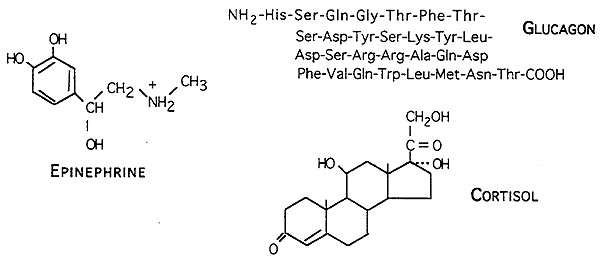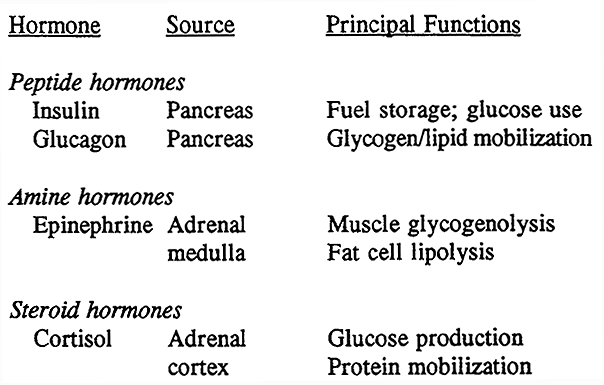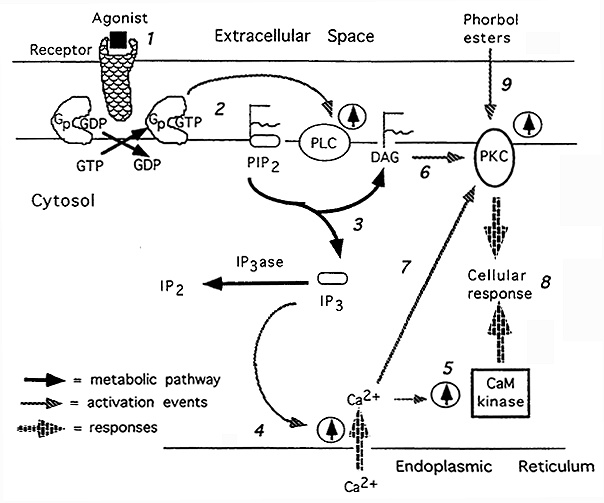
Overview of Biochemical Endocrinology
Hormone- "chemical substance secreted by a ductless gland into blood that is transported to a distant target organ whose activity it specifically affects".
Target Tissues- have receptors or specific binding proteins for each hormone
Properties of Hormones:
1. They are biosynthesized.
2. They operate at vanishingly small concentrations in blood (10-12 to 10-8 M, nano-pico).
3. They have short half lives.
4. They often exert multipoint control and operate at a number of target organs; hormones awaken existing potential in target cells that are preprogrammed to respond.
5. They are feedback regulated by: (a) themselves, (b) the product(s) of their action, (c) the central nervous system.
Chemistry
There are several chemically distinct classes of hormones: amine(epinephrine), peptide (insulin, glucagon) and steroid (cortisol).

Insulin, Glucagon, Epinephrine and Cortisol are the Hormones that Control Glucose Homeostasis:

Hormone Receptors:
Interaction between hormone and receptor forms the "hormone receptor complex".
Strength of binding is expressed as the dissociation constant Kd, the concentration at which the binding sites are half-saturated.
Classification of Hormones by Receptor Properties:
Group I: Hormones that bind to intracellular receptors: Glucocorticoids, mineralocorticoids, estrogens, progestins, androgens, vitamin D, thyroid, retinoic acid
Group II: Hormones that bind to cell surface receptors:
Group IIA: The second messenger is cAMP: vasopressin, glucagon, b-adrenergic catecholamines, somatostatin, opioids.
Group IIB: The second messengers are IP3 (inositol trisphosphate) / Ca2+ and diacylglycerol (DAG): oxytocin, angiotensin II, a-adrenergic catecholamines.
Group IIC: The cell surface receptor posses tyrosine protein kinase activity (intracellular messenger unknown): insulin, growth factors.
Group IIC': The cell surface receptor recruits soluble tyrosine kinases: growth hormone.
Group IID: The second messenger is cGMP: atrial natiuretic peptide (ANP).
General Features of Hormone Classes, Group I and Group II:
| Feature | Group I | Group II |
| Solubility | Lipophilic | Hydrophilic |
| Plasma T1/2 | Long (Hours to Days) | Short (Minutes) |
| Receptor Location | Intracellular | Plasma Membrane |
| Signal Mediator | Receptor-Hormone Comp. | cAMP,cGMP,Ca2+,IP3,DAG |
Steroid / Thyroid / Retinoic Acid Hormone Actions:
Group I- lipophilic, derived from cholesterol (except thyroid and retinoic acid)
Passively diffuse through the plasma membrane of the target cell to associate with their receptors.
The hormone-receptor complex is assumed to be the intracellular messenger
Effects of these hormones are quite specific.
Cell Surface Acting Hormone Action:
Group II: peptide and amine hormones bind to membrane spanning receptors (7 transmembrane); communicate through second messengers, cAMP (Group IIA) or Ca2+ / IP3 / DAG (Group IIB).
G-Proteins
Review
E = The Effector Protein, Adenylate Cyclase
R = Receptor, 7-transmembrane cell surface receptor

Note: once the Effector protein is active the second messenger c-AMP is produced activating Protein Kinase A and starting a "cascade" of events leading to transmission of message and physiological / biochemical responses.
Hormones Functioning via IP3 / Ca2+ and DAG:
PIP2 = Phosphatidylinositol-4,5-bisphosphate
IP3 = Inositol-1,4,5-triphosphate
DAG = Diacylglycerol
PLC = Phospholipase C
PKC = Protein Kinase C
CaM Kinase = Calmodulin Kinase

[1] hormones bind to receptor
[2] receptor is coupled to phospholipase C by Gp
[3] Phospholipase C splits PIP2 into IP3 and DAG
[4] and [5] IP3 mobilizes intracellular (stored) Ca2+ from the ER for activation of CAM
[6] and [7] DAG activates protein kinase C which is further activated by Ca2+
[8]the concerted action of these two kinases elicit cellular responses
Clinical Correlate
Bacterial Toxins:
Symptoms: watery stools, vomiting, cyanotic, low blood pressure, rapid / weak pulse
Treatment: IV solution of elctrolytes, tetracycline
Cause: cholera toxin inhibits GTPase preventing breakdown of GTP to GDP and locking the a subunit in the activated state producing a continuous oversupply of cAMP
Freezes Gi leaving Gs continuallt active, producing an oversupply of cAMP

© Dr. Noel Sturm 2015